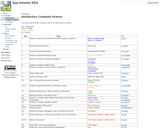Students will read and observer ants to discover how ants are the same and different than people.
- Subject:
- Elementary English Language Arts
- Material Type:
- Lesson
- Author:
- Utah Lesson Plans
- Date Added:
- 09/08/2021
Students will read and observer ants to discover how ants are the same and different than people.

This task requires students to work with very large and small values expressed both in scientific notation and in decimal notation (standard form). In addition, students need to convert units of mass.

In this webinar, learn about all recent and upcoming changes and updates to Google for Edu programs.

Apexer is a street artist who creates colorful, spray-painted murals around the world. Using a visual foundation based in graffiti art and Chinese calligraphy, Apexer abstracts letterforms to create complex, dynamic compositions for his street art projects. Often creating artworks that communicate the vibe of the neighborhood where they are on view, Apexer’s painted gestures are accessible to a wide audience, and are constantly expanding upon the core element of his work: the letters of his nickname.

How can one interpret the Apotheosis of Washington? What symbols, stories and artistic approach did Constantino Brumidi employ?

A six-week App Inventor curriculum unit for an introductory CS course

Designing apps is great way to work together to solve challenges you care about. And by hosting an in-person or virtual app showcase, you give aesiring coders a chance to celebrate their ingenuity as they present their ideas and share their solutions with peers, families, and the community.

This document expounds on the relationship between the Nature of Science and new science standards.

This three-act math task utilizes videos and questioning to help students explore multiplying and dividing fractions.

What is the relationship between the Declaration of Independence and the Constitution? How do these Founding documents reflect common republican principles?

Learn about apples, how and where they grow, the different parts of an apple, and what we can make from an apple.

This resource includes the sheet music, activity instructions, and audio files for "Apples and Bananas" from the Elementary Songbook.

This resource is a free, downloadable audio file of short music clips to use for instruction.

This resource includes the sheet music, activity instructions, and audio files for "Apples and Bananas" from the Elementary Songbook.

This resource is a free, downloadable audio file of short music clips to use for instruction.

An introduction to how AI is applied in daily life and across industries, including aspects of AI such as NLG and speech recognition. This module is part of the AI Foundations: Imagine Cup Juniors learning path.

Applied Calculus instructs students in the differential and integral calculus of elementary functions with an emphasis on applications to business, social and life science. Different from a traditional calculus course for engineering, science and math majors, this course does not use trigonometry, nor does it focus on mathematical proofs as an instructional method.

Teach students using engaging lessons with blend technology tools with content area knowledge.

This is a lesson plan created for Earth Day using an Applied Digital Skills lesson. After providing students with background on Earth Day, students will take charge of their learning by following the lesson to explore a topic centered around Earth Day. Students will be creating a presentation using a Google Application and will share the presentation with the class.

Laszlo Tisza was Professor of Physics Emeritus at MIT, where he began teaching in 1941. This online publication is a reproduction the original lecture notes for the course "Applied Geometric Algebra" taught by Professor Tisza in the Spring of 1976. Over the last 100 years, the mathematical tools employed by physicists have expanded considerably, from differential calculus, vector algebra and geometry, to advanced linear algebra, tensors, Hilbert space, spinors, Group theory and many others. These sophisticated tools provide powerful machinery for describing the physical world, however, their physical interpretation is often not intuitive. These course notes represent Prof. Tisza's attempt at bringing conceptual clarity and unity to the application and interpretation of these advanced mathematical tools. In particular, there is an emphasis on the unifying role that Group theory plays in classical, relativistic, and quantum physics. Prof. Tisza revisits many elementary problems with an advanced treatment in order to help develop the geometrical intuition for the algebraic machinery that may carry over to more advanced problems. The lecture notes came to MIT OpenCourseWare by way of Samuel Gasster, '77 (Course 18), who had taken the course and kept a copy of the lecture notes for his own reference. He dedicated dozens of hours of his own time to convert the typewritten notes into LaTeX files and then publication-ready PDFs. You can read about his motivation for wanting to see these notes published in his Preface below. Professor Tisza kindly gave his permission to make these notes available on MIT OpenCourseWare.